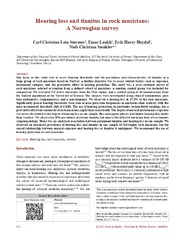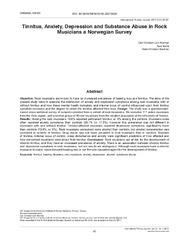| dc.contributor.advisor | Stenklev, Niels Christian | |
| dc.contributor.author | Størmer, Carl Christian Lein | |
| dc.date.accessioned | 2018-12-19T12:16:40Z | |
| dc.date.available | 2018-12-19T12:16:40Z | |
| dc.date.issued | 2018-12-14 | |
| dc.description.abstract | Musicians are known to have an increased prevalence of hearing loss and tinnitus due to noise-induced cochlear damage. Rock music is popularly considered a major culprit in terms of excessive sound levels, but the literature on hearing in rock musicians is sparse. In this dissertation the hearing levels of a large number of rock musicians are assessed in relation to factors such as degree of exposure, instrument category, use of hearing protection and the presence of various psychological characteristics.
In the first part of the dissertation, the degree of hearing loss is assessed using transient evoked otoacoustic emissions (TEOAEs), under the assumption that cochlear injury could be identified at an early stage by measuring otoacoustic emissions in musical noise-exposed individuals. Within the rock musician sample, a loss of TEOAE SNR in the 4 kHz half- octave frequency band was observed. However, this loss was strongly predicted by age and pure-tone thresholds in the 3 - 6 kHz range.
In the second part of the dissertation, the degree of hearing loss is assessed using pure-tone audiometry. A hearing loss in 37.8% (95% C.I.: 28.8 - 46.8%) of the rock musicians was observed and significantly poorer hearing thresholds were found at most pure-tone frequencies with the most pronounced threshold shift at 6 kHz. The use of hearing protection had a preventive effect. Unexpectedly, the degree of musical performance exposure was inversely related to degree of hearing loss.
In the third part of the dissertation, the prevalence and symptomatology of tinnitus is assessed, and the distribution of anxiety and depression symptoms among rock musicians with or without tinnitus is analyzed. The aim was to study how mental health indicators and internal locus of control influence their tinnitus-related concerns, and to what degree tinnitus affects their life. A prevalence of permanent tinnitus at 19.8% (95% C.I.: 14.3 - 29.7%) was identified in rock musicians, which is significantly higher than in a normal population. There is an association between chronic tinnitus and depressive symptoms in rock musicians, but the results are ambiguous. There was an increased risk for anxiety and alcohol abuse in the rock musician sample, but these factors were unrelated to severity of tinnitus.
4
Neither pure-tone hearing thresholds nor TEOAEs differed significantly between the tinnitus- affected musicians and non-tinnitus-affected musicians. This suggests that cochlear damage is not the sole causative agent in tinnitus sufferers.
This work contributes to the understanding of the relationship between rock musical noise exposure and hearing loss. Rock musicians are at increased risk for developing cochlear damage leading to hearing loss and tinnitus, but tinnitus may also be caused by other factors. These findings merit further research. | en_US |
| dc.description.doctoraltype | ph.d. | en_US |
| dc.description.popularabstract | Musicians are known to be at risk of developing hearing loss and tinnitus.
In this dissertation, the largest study to date on hearing disorders in rock musicians is presented. Rock musicians are at an increased risk of developing hearing loss and tinnitus, but the study also shows that musicians tend to develop an increased resistance towards developing hearing loss. Furthermore, damage to the inner ear does not seem to be the sole causative factor in the development and management of tinnitus. | en_US |
| dc.description.sponsorship | UiT The Arctic University of Norway | en_US |
| dc.identifier.uri | https://hdl.handle.net/10037/14370 | |
| dc.language.iso | eng | en_US |
| dc.publisher | UiT The Arctic University of Norway | en_US |
| dc.publisher | UiT Norges arktiske universitet | en_US |
| dc.relation.haspart | <p>Paper I: Høydal, E.H., Størmer, C.C.L., Laukli, E. & Stenklev, N.C. (2017). Transient evoked otoacoustic emissions in rock musicians. <i>International Journal of Audiology, 56</i>(9), 685-691. Full text not available in Munin due to publisher restrictions. Available at <a href=https://doi.org/10.1080/14992027.2017.1321788>https://doi.org/10.1080/14992027.2017.1321788. </a><p>
<p>Paper II: Størmer, C.C.L., Laukli, E., Høydal, E.H. & Stenklev, N.C. (2015). Hearing loss and tinnitus in rock musicians: A Norwegian survey. <i>Noise & Health, 17</i>(79), 411-421. Also available at <a href=http://hdl.handle.net/10037/8713>http://hdl.handle.net/10037/8713. </a><p>
<p>Paper III: Størmer, C.C.L., Sørlie, T. & Stenklev, N.C. (2017). Tinnitus, Anxiety, Depression and Substance Abuse in Rock Musicians a Norwegian survey. <i>International Tinnitus Journal, 21</i>(1), 50-57. Also available at <a href=https://doi.org/10.5935/0946-5448.20170010> https://doi.org/10.5935/0946-5448.20170010.</a><p> | en_US |
| dc.rights.accessRights | openAccess | en_US |
| dc.rights.holder | Copyright 2018 The Author(s) | |
| dc.rights.uri | https://creativecommons.org/licenses/by-nc-sa/3.0 | en_US |
| dc.rights | Attribution-NonCommercial-ShareAlike 3.0 Unported (CC BY-NC-SA 3.0) | en_US |
| dc.subject | Rock music | en_US |
| dc.subject | Hearing loss | en_US |
| dc.subject | Tinnitus | en_US |
| dc.subject | Depression | en_US |
| dc.subject | Anxiety | en_US |
| dc.subject | Substance abuse | en_US |
| dc.subject | VDP::Medical disciplines: 700 | en_US |
| dc.subject | VDP::Medisinske Fag: 700 | en_US |
| dc.title | Hearing in rock musicians | en_US |
| dc.type | Doctoral thesis | en_US |
| dc.type | Doktorgradsavhandling | en_US |


 English
English norsk
norsk


